The stories of the buildings of the United States and their residents are indivisible from the history of the nation itself. The character of the oldest building of each city evokes the hopes, dreams and conflicts experienced by our ancestors. Many of them came to the country as immigrants in search of a safe and prosperous new homeland. Others experienced the colonization of the United States as a fight for survival. In every case, these buildings represent the daily struggle and monumental legacy of those who lived there.
The Oldest Building in Each of the Top 100 Cities in the United States
From adobe huts to a temporary capital for a short-lived microstate, and from the living quarters of slaves to the vast mansions in which their owners lived, this collection represents 300 years of the landscape.
An illustrated tribute was given to the most endangered wildlife in every state in the United States in this article back on Friday, March 1, 2019; an illustrated tribute was given to the most endangered plant in every state in the United States in this article back on Sunday, January 19, 2020; and an illustrated tribute was given to the most endangered building in every state in the United States in this article back on Saturday, February 1, 2020 here at The Gate; and this article which you are reading now is similarly devoted to the oldest building in each of the top 100 cities in the United States.
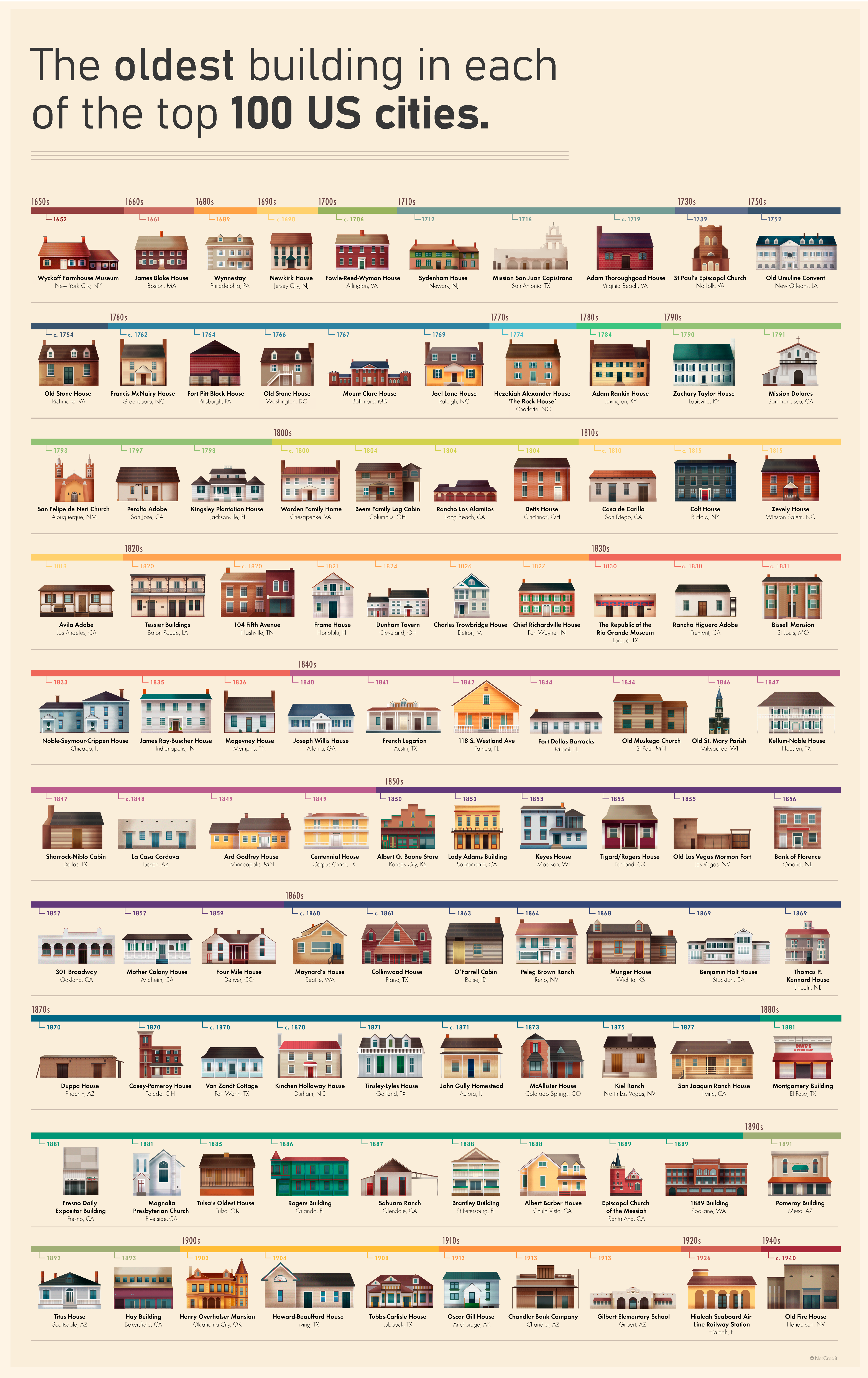
Not everybody agrees when each building was constructed. In some cases, an old building began life outside the city limits and only ‘grew into’ the city as the boundaries expanded. Some old buildings were moved wholesale from one place to another in the name of preservation.
Using estimates from the Census Bureau of the United States to identify the most populous cities in the land — as well as research of local media sources, databases and official records to figure out which was the oldest building in each of these cities — a series of posters which celebrates the oldest building in each of the top 100 cities in the United States has been created; and this article from NetCredit contains the arguably definitive list, of which local historical and heritage societies were checked and consulted for pertinent information prior to finalizing that list.
I have been given express written permission to use the images and the verbatim text from the aforementioned article in this article. With articles such as this one, I sometimes add brief notes — and although I am not knowledgeable enough about them to add much value to the information which is already here, I do point out one inaccuracy about which I know towards the end of this article.
1. 1650s
The oldest building in our study is the 1652 Wyckoff House in Canarsie, NYC. It started as a modest, one-room farmhouse for Pieter Wyckoff, his wife Grietje, and their 11 children. The house was enlarged a century later as the farm thrived, and it was remodeled in 1819, remaining in the hands of Wyckoff’s descendants until 1901. Original woodwork still bears the mark of the original carpenter’s hand, and a 1980s restoration utilized wood from a 17th-century barn. A visit to the museum house today offers a cut-away glance at how it has evolved over nearly 400 years.
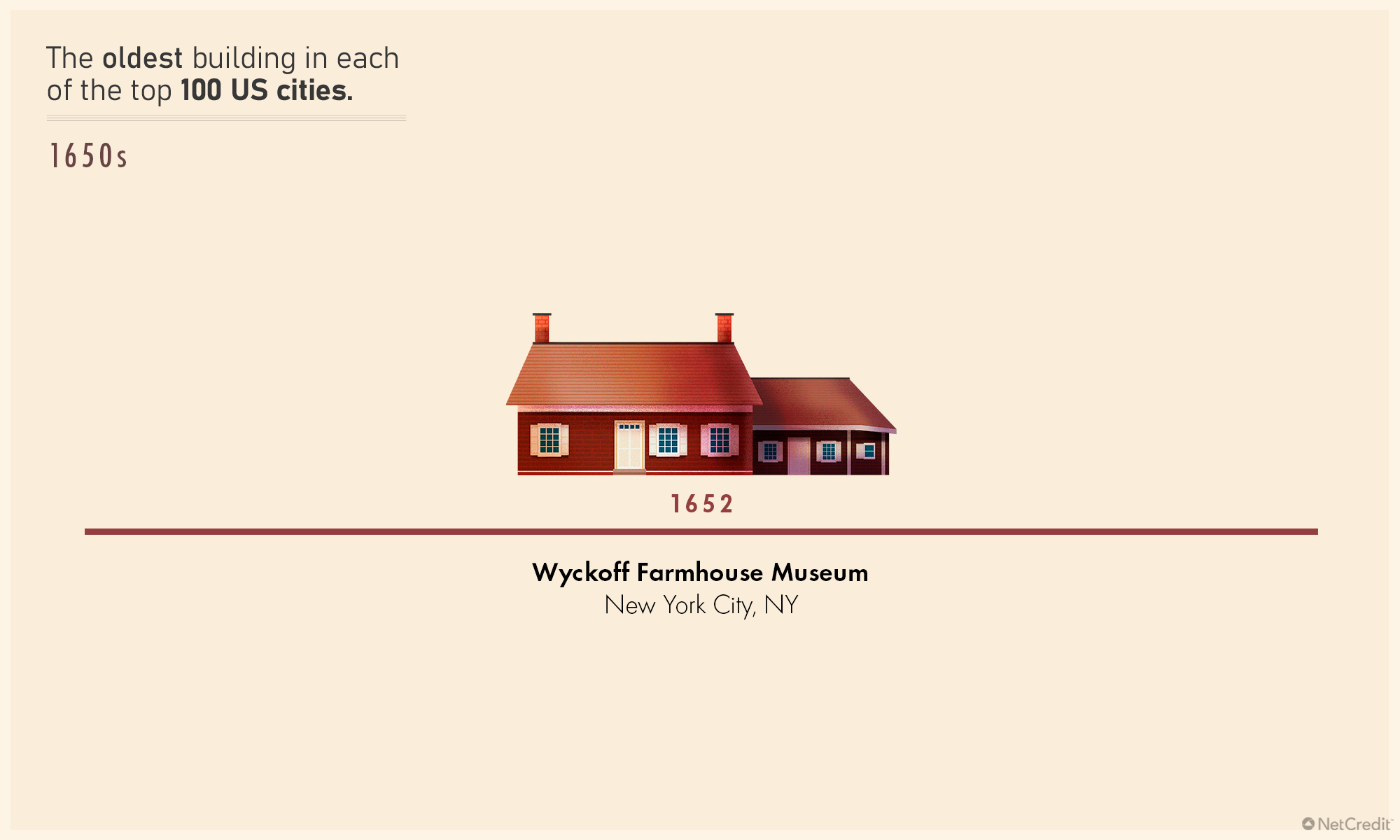
2. 1660s
Boston’s oldest building is on Columbia Road, Dorchester, although it was moved from its original position on Massachusetts Avenue in 1895-96. The James Blake House is a rare American example of ‘West England country framing’ (the use of heavy timber-framing methods that were common in the west of England at the time). It is two stories high with a central chimney and gable-roof dwelling and was formerly part of a 91-acre estate owned by the deacon, constable, town selectman and General Court deputy James Blake.

3. 1680s
Thomas Wynne built Wynnestay in Philadelphia in 1689 within a decade of the city being founded. In fact, Wynne bought the 5,000-acre property from the city’s founder, William Penn (the son of the man who founded and gave his name to Pennsylvania). It is the oldest stone-built residential home in the state. Architect Walter Smedley designed some changes for the house in 1905, half a century after the Wynnes finally moved out. Smedley raised the roof and added the north wing and staircase, without compromising the original character of the building.

4. 1690s
Jersey’s Newkirk House was built sometime around 1690 using timber and ruddy sandstone blocks. It looks different today to how it did back then, due to a number of modifications over the years, including alteration of the façade in 1928. When Newkirk House was transformed into a restaurant in 1979, renovators discovered that it had gained its second story some point after the original construction – having begun life as a single-story Dutch Colonial-style home.
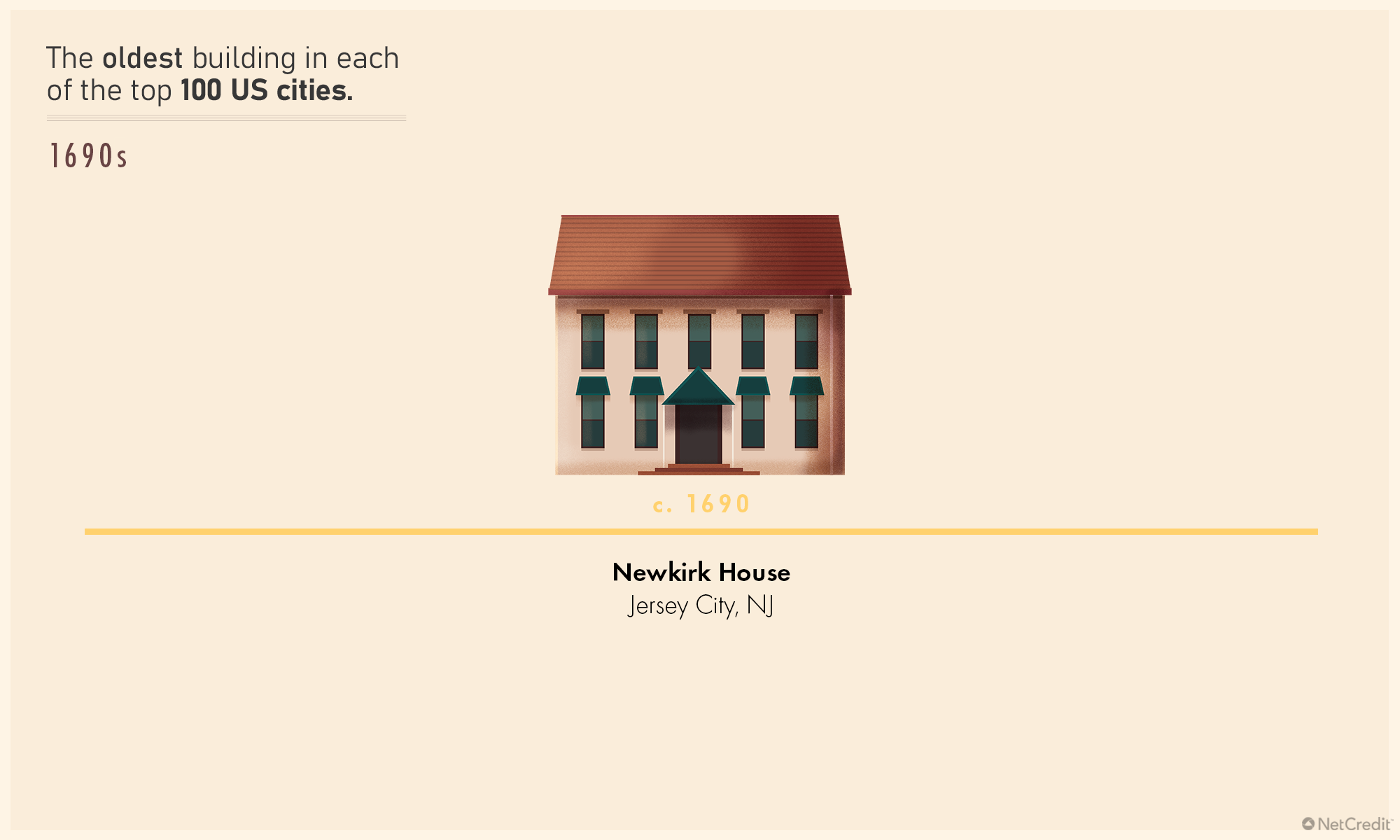
5. 1700s
Arlington, Virginia’s oldest building was built around 1706. The Fowle-Reed-Wyman House at 64 Old Mystic St. is a two-story, saltbox house. John Fowle erected it on land formerly owned by Pawtucket Confederation Squaw Sachem. The house remained surrounded by farmland until the turn of the 20th century. A suburban community blossomed around the house, and its significance to the community grew even as its acreage shrank.
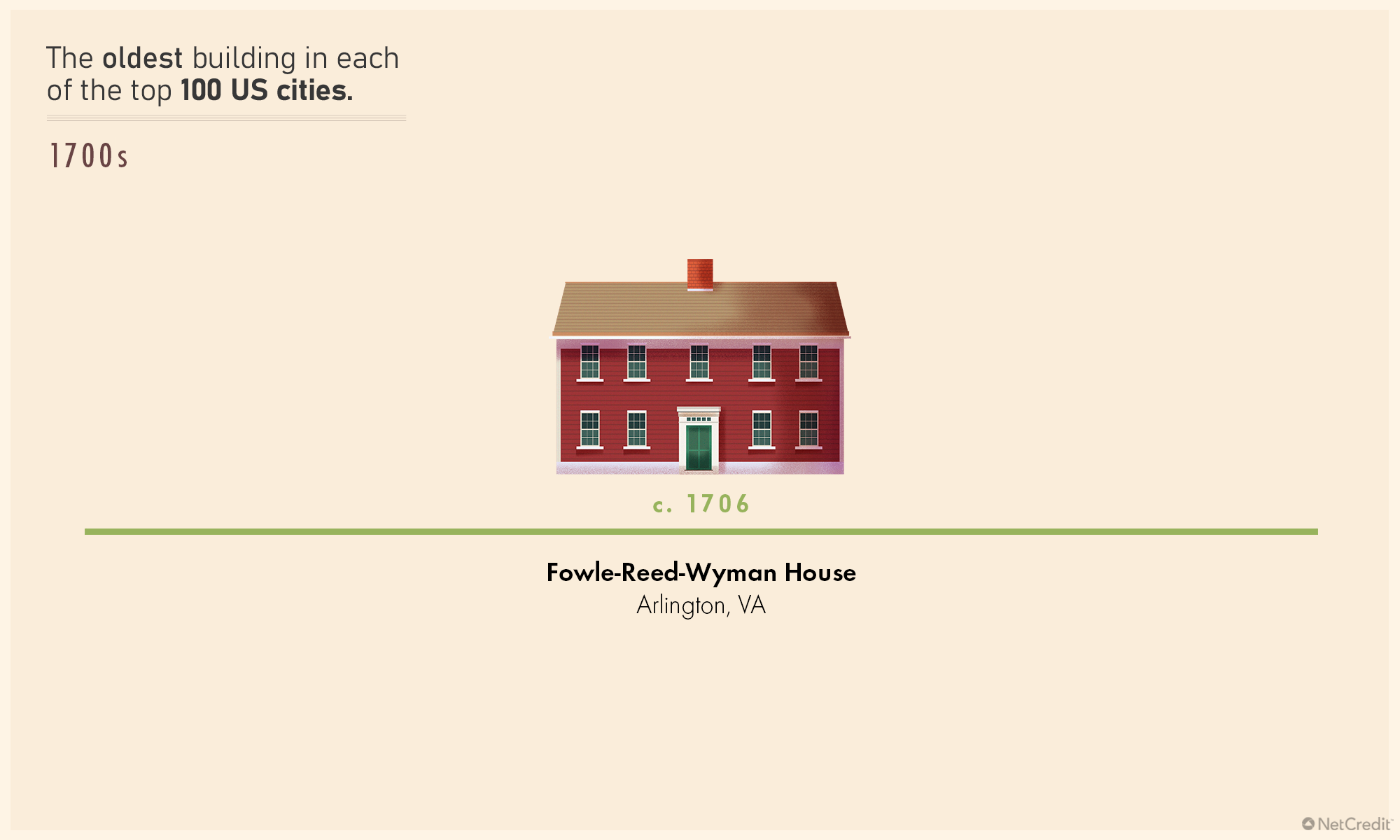
6. 1710s
Newark, San Antonio and Virginia Beach can all trace their oldest houses to the 1710s. Newark’s Sydenham House at 29 Old Road to Bloomfield is a saltbox structure and originally had just two rooms. It has since expanded, but renovations and restorations have been sympathetic to the original. San Antonio’s oldest is the San Juan Capistrano Mission. It actually used to be the East Texas mission of San Jose de los Nazonis but got a new name when the whole structure was moved to its current location.
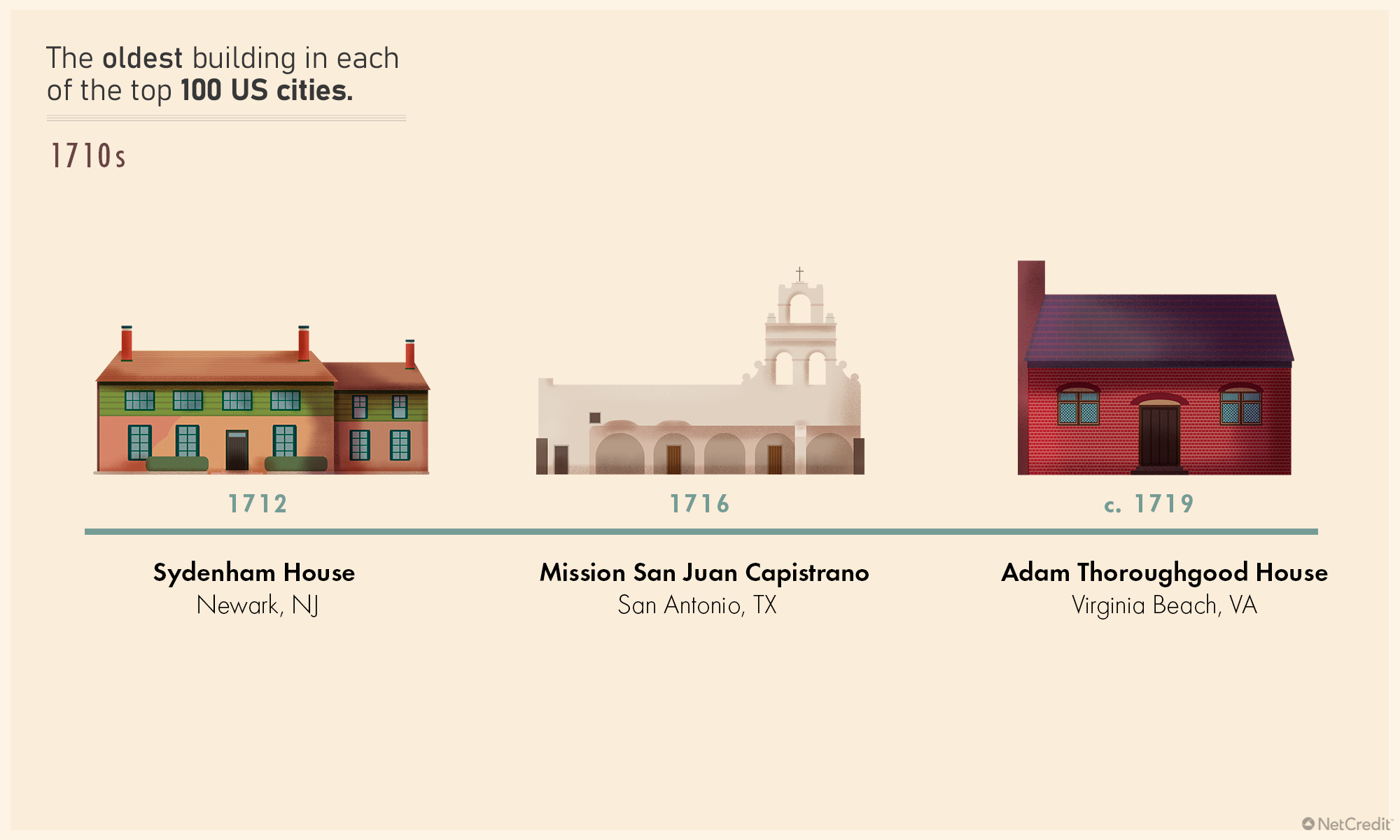
7. 1730s
On New Year’s Day of 1776, British Navy ships shelled the town of Norfolk, Virginia, and later dispatched landing parties to burn the buildings being used as Revolutionary sniper points. The Revolutionaries, too, began to burn and also loot buildings – those belonging to fleeing Loyalists. The only structure that survived the destruction was the 1739 St. Paul’s Episcopal Church, and it stands today as Norfolk’s oldest building. A cannonball that struck the church that New Year’s Day can still be seen embedded in the wall.
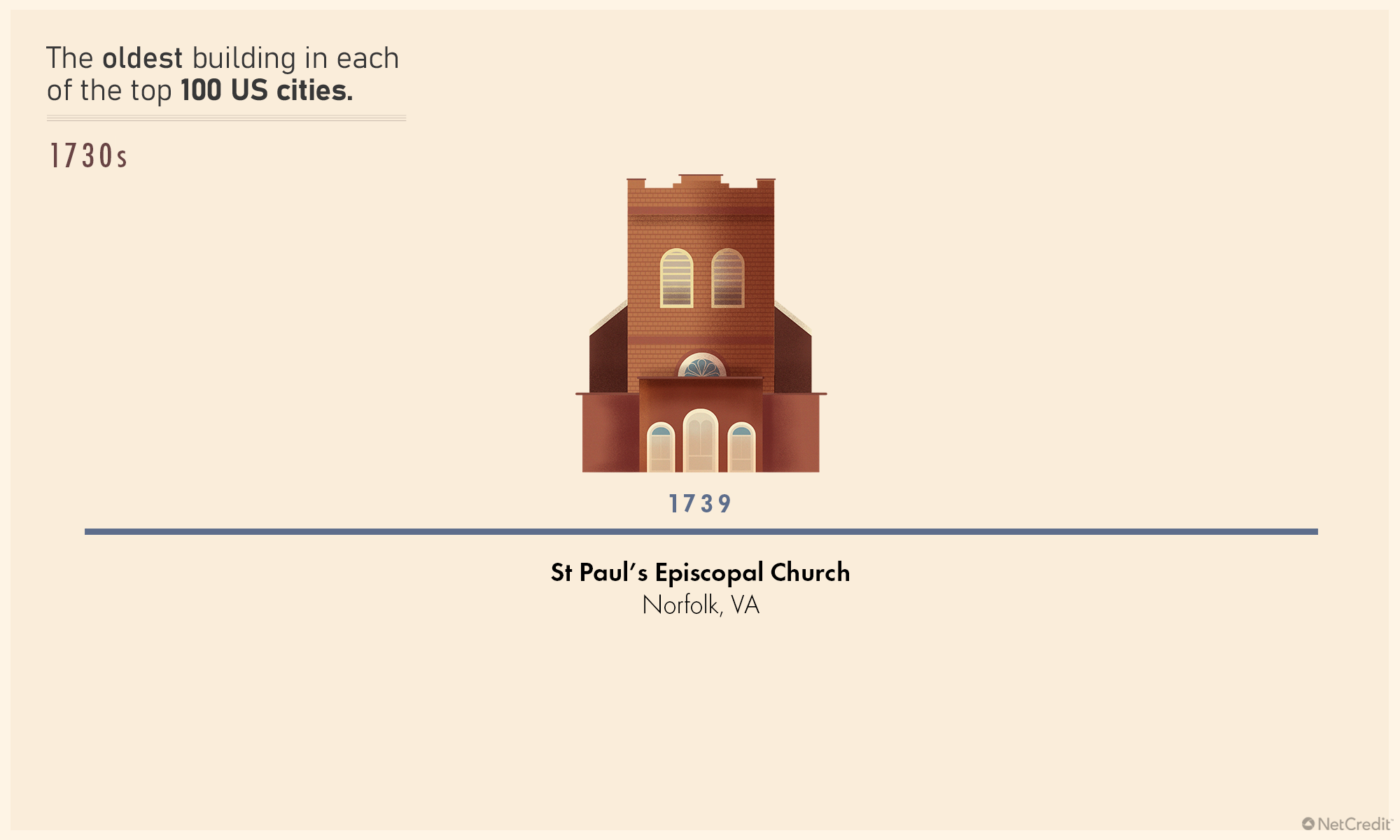
8. 1750s
As a lieutenant of the Richmond youth honor guard, a young Edgar Allan Poe once stood guard outside the city’s 1754 Old Stone House – although there’s no evidence he ever went inside. Today, the house is part of a museum to Poe. The coursed rubble stonework is a rare example of its kind. The gable roof features two end chimneys and three asymmetrical dormers.
The Old Ursuline Convent in New Orleans predates the Old Stone House by two years. New Orleans’ oldest building was authorized by Louis XV himself. The architects adapted French architectural principles to the needs, materials, and conditions of the Deep South.
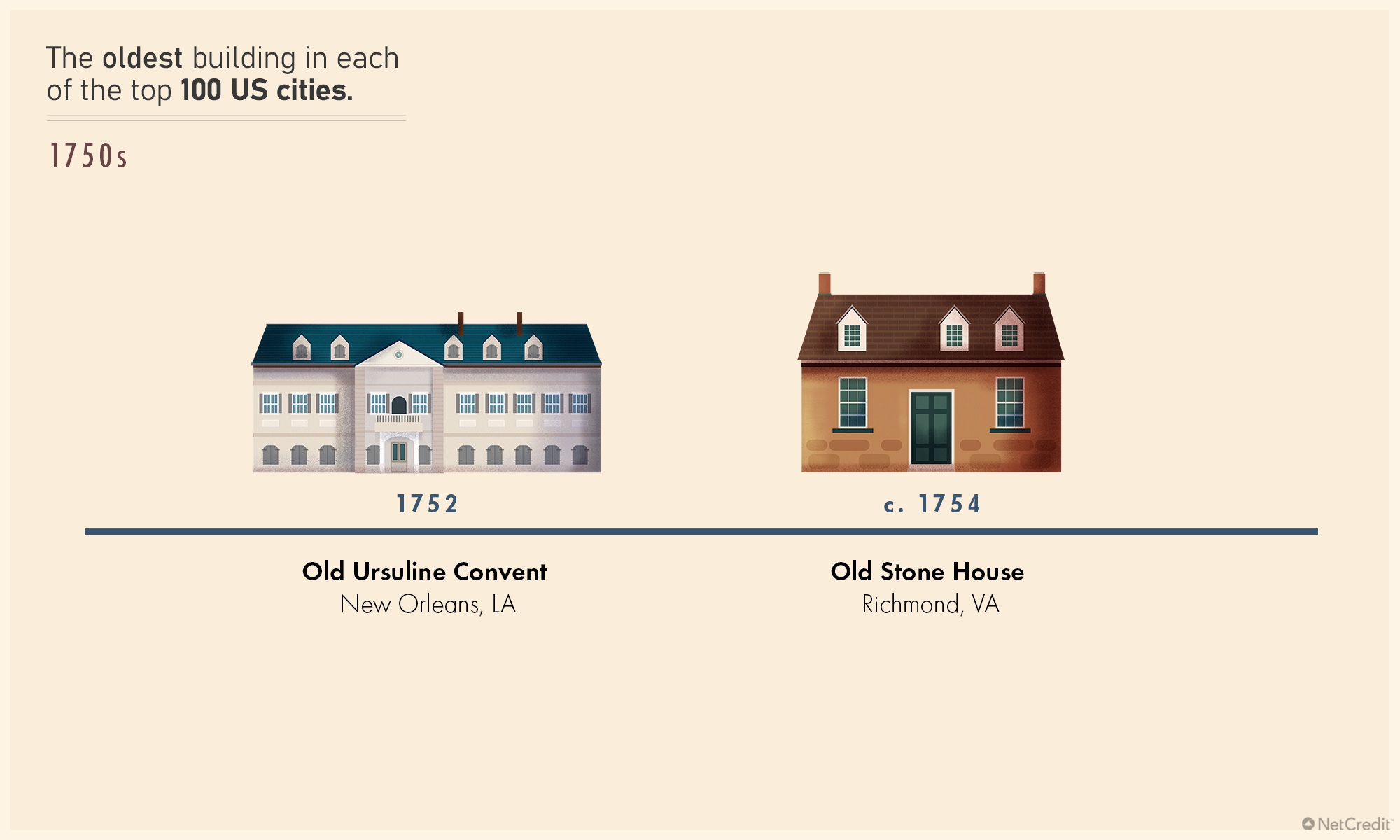
9. 1760s
Washington’s oldest building is another ‘Old Stone House.’ The vernacular, blue granite and fieldstone house was saved from development by the ‘false memory’ that Washington himself had stayed there. He had, in fact, stayed at a nearby inn belonging to the same family.
The Francis McNairy House is Greensboro, North Carolina’s longest-standing building – although it was moved eight miles to its present site in 1967. This two-story log house was a family home and doubled as a field hospital after the 1781 Battle of Guilford Courthouse.
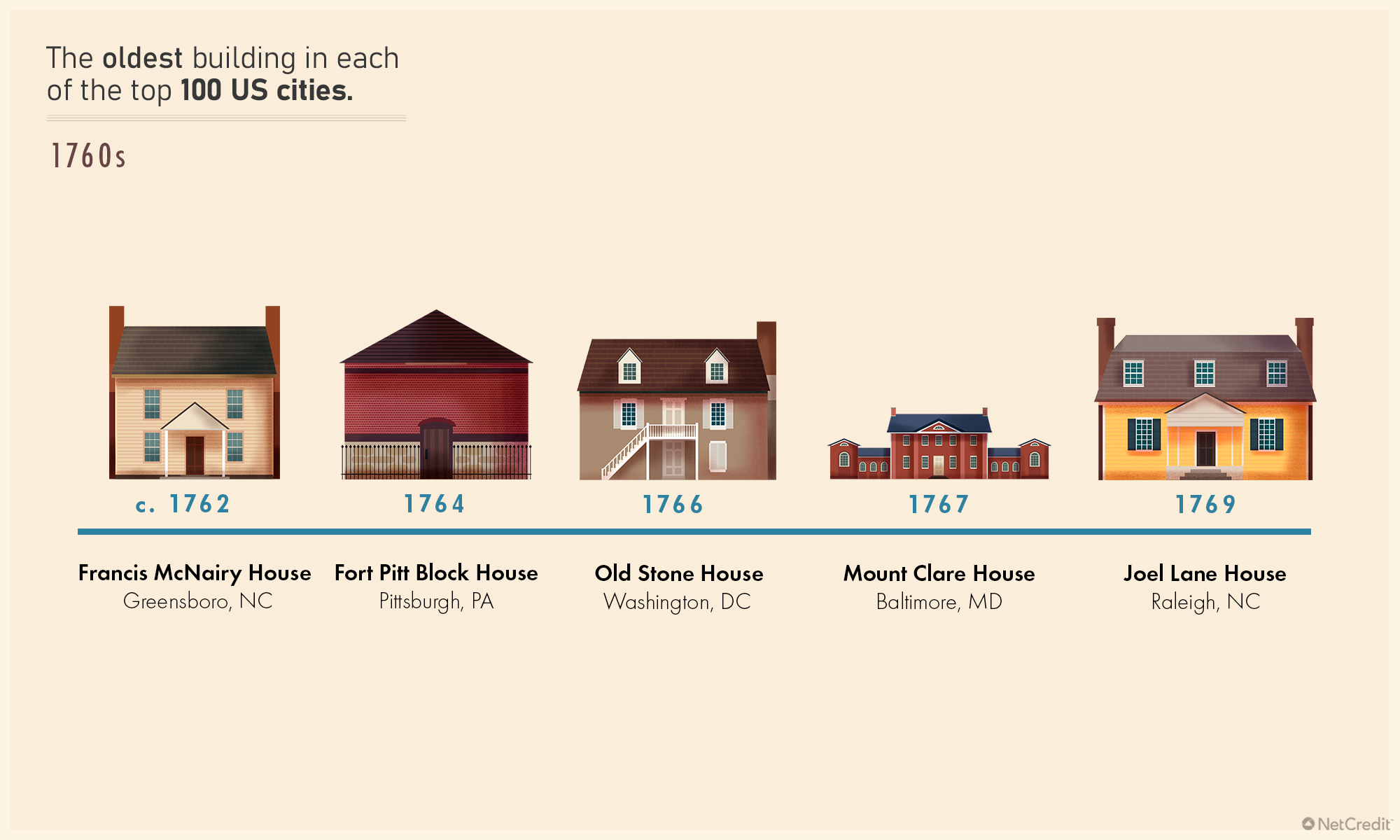
10. 1770s
Blacksmith, farmer and future congressman Hezekiah Alexander built Charlotte’s oldest building in 1774. The ‘Rock House’ is made of native Piedmont stone, and an ‘X’ in one of the stones suggests it was completed in October of that year. It is typical of the style of house built by Pennsylvania Germans and the Hudson Valley Dutch, although Alexander was a second-generation Scottish immigrant.
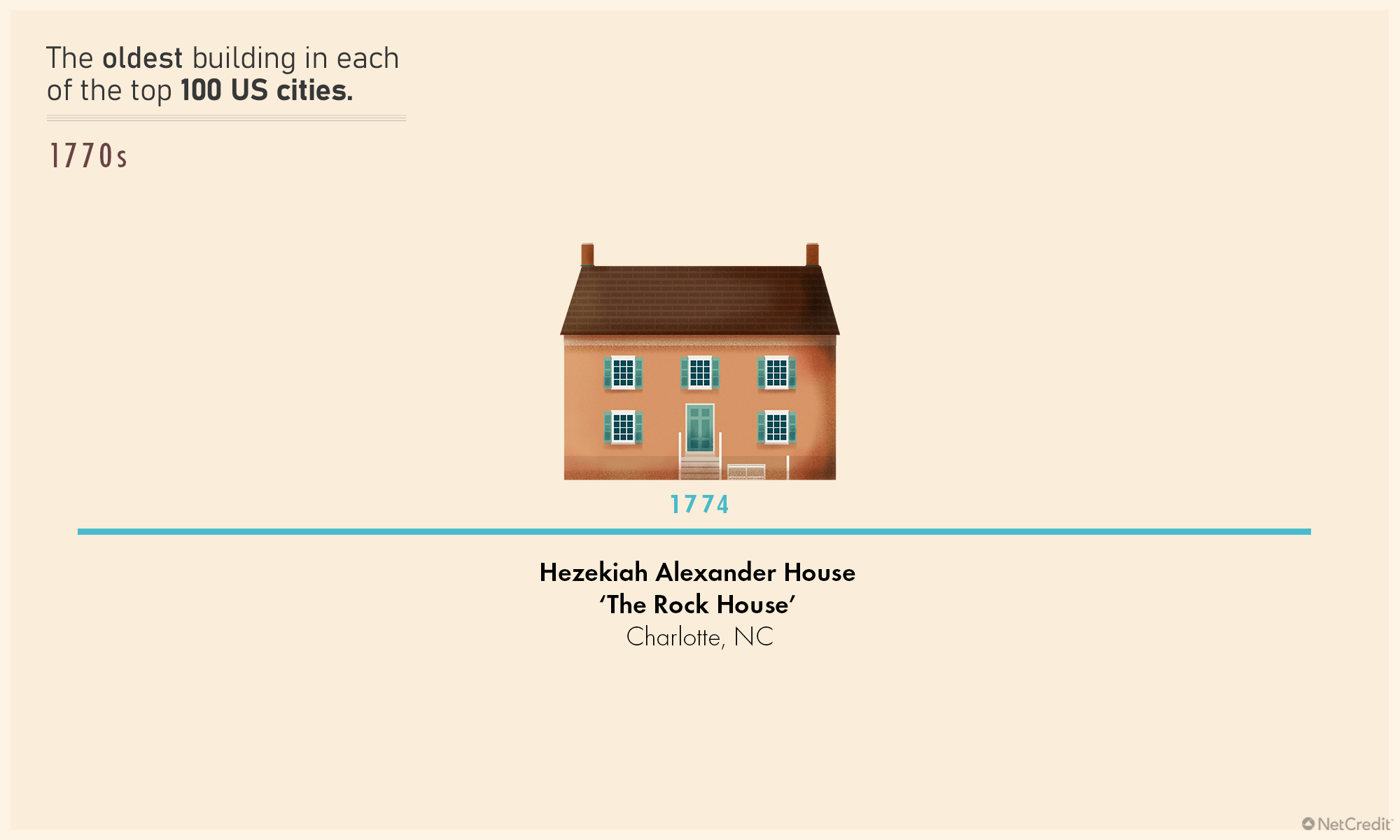
11. 1780s
The South Hill Historic District of Lexington boasts a rich variety of 19th-century Federal and Greek Revival houses, including work by John McMurtry and Cincinnatus Shyrock. The oldest building in town is the Adam Rankin House from 1784. It is built from dovetailed logs and once featured an eight-foot-broad chimney at the west end, probably made from stone. The Adam Rankin House originally had an open townhouse layout, but renovations and extensions over the years have changed the inside substantially. The whole building was relocated in 1972 and can now be found at 317 South Mill Street.
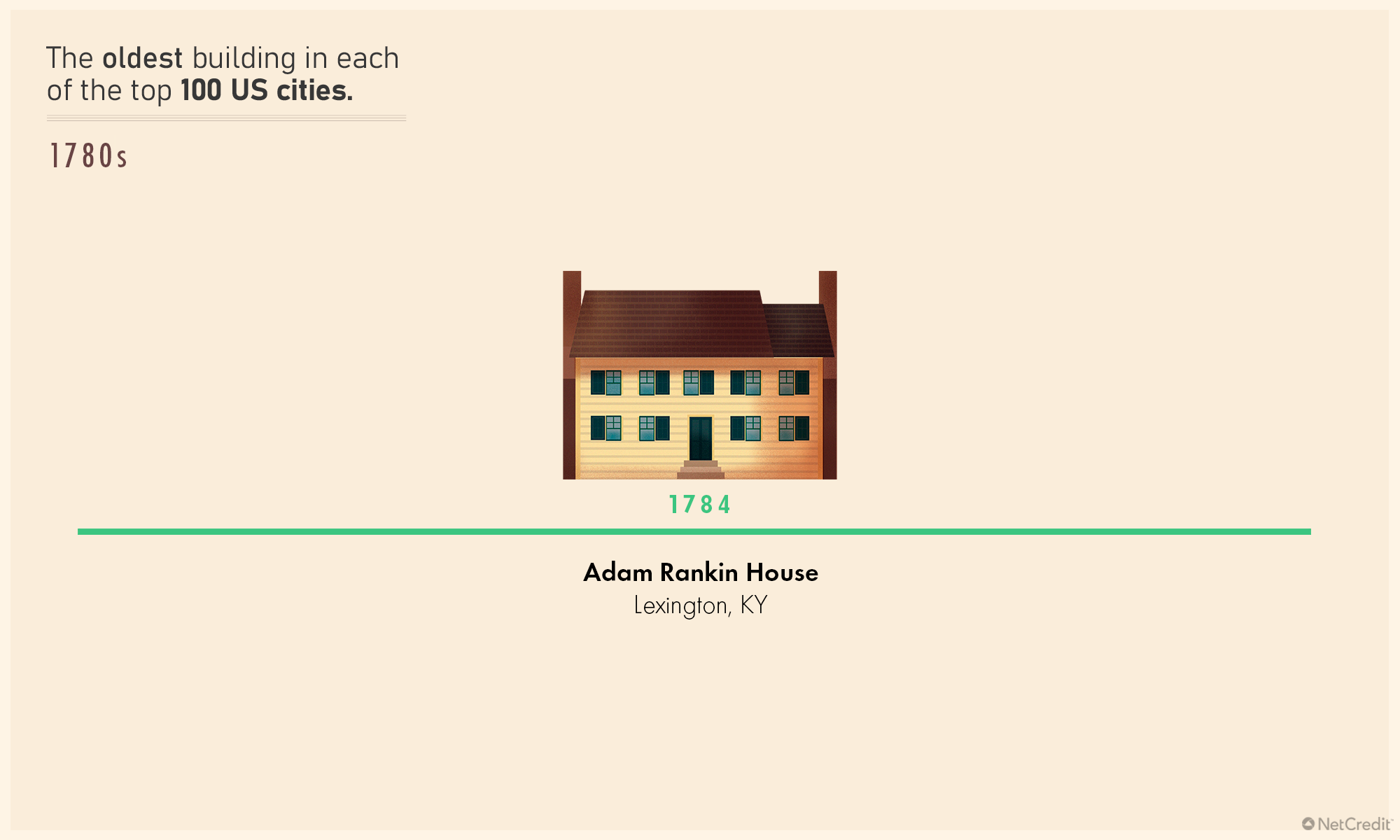
12. 1790s
Zachary Taylor, the 12th President of the United States, grew up in a 2½-story Georgia Colonial L-shaped brick house in Louisville, Kentucky. It has now been named after him. He also married there and saw five of his children born in his childhood home. Taylor’s father, Colonel Richard Taylor, used slave labor to build the house on the highest point of his 400-acre farm Muddy Fork of Beargrass Creek, completing it in 1790. Today, it is Louisville’s oldest building.
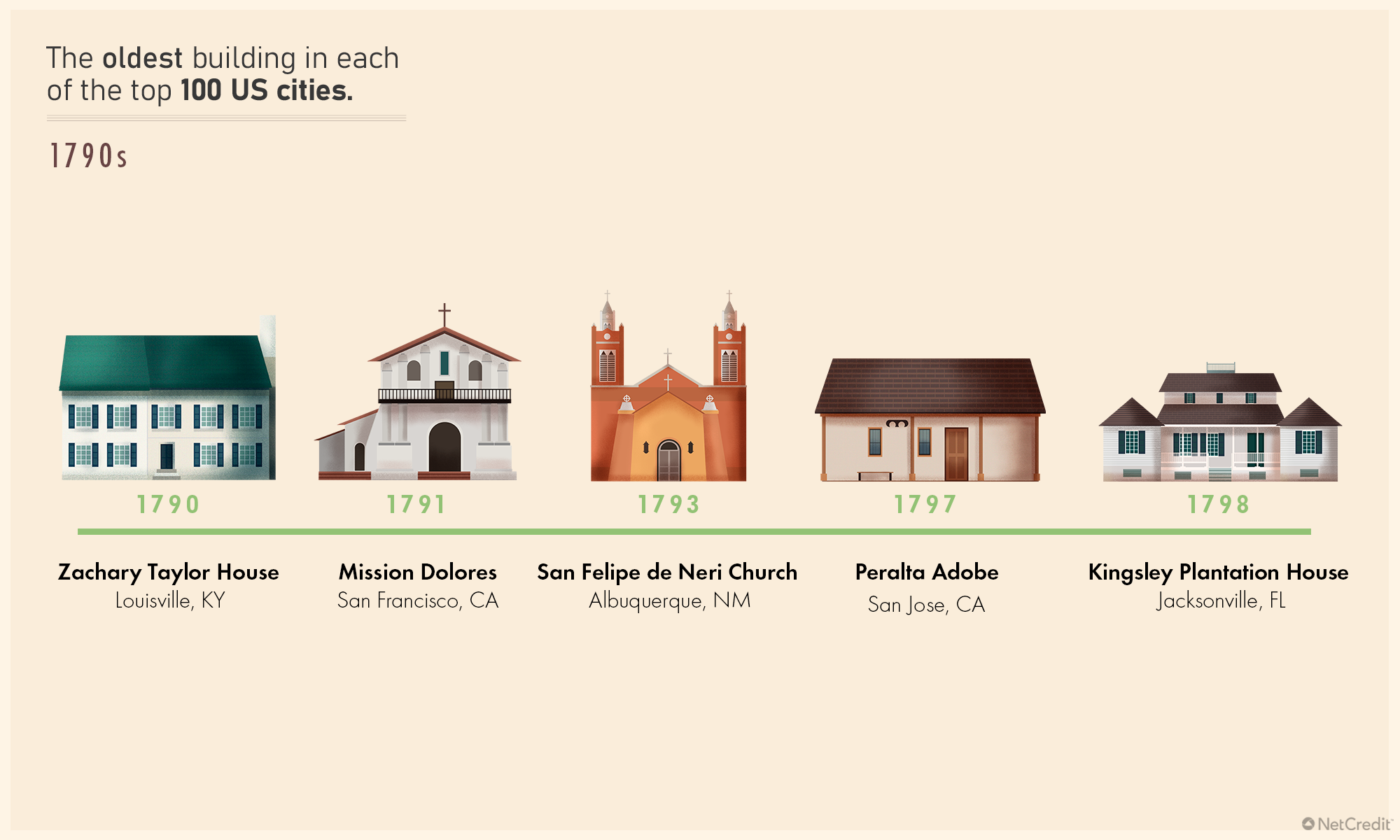
13. 1800s
David Beers built his family log cabin near Dodridge Street, Columbus, OH, in 1804, although it was later relocated to E. Norwich Avenue. The Beers family still live in Columbus, and only two families have ever lived in the house that David Beers built.
While Beers was building his Columbus home, Manuel Nieto was building Rancho Los Alamitos – now Long Beach’s oldest building. He constructed on the land of the native Gabrielino-Tongva tribe. The main building is adobe in style. Notable landscape designers Frederick Law Olmsted, Jr. and Florence Yoch & Lucile Council later added gardens, which are also of historical note.
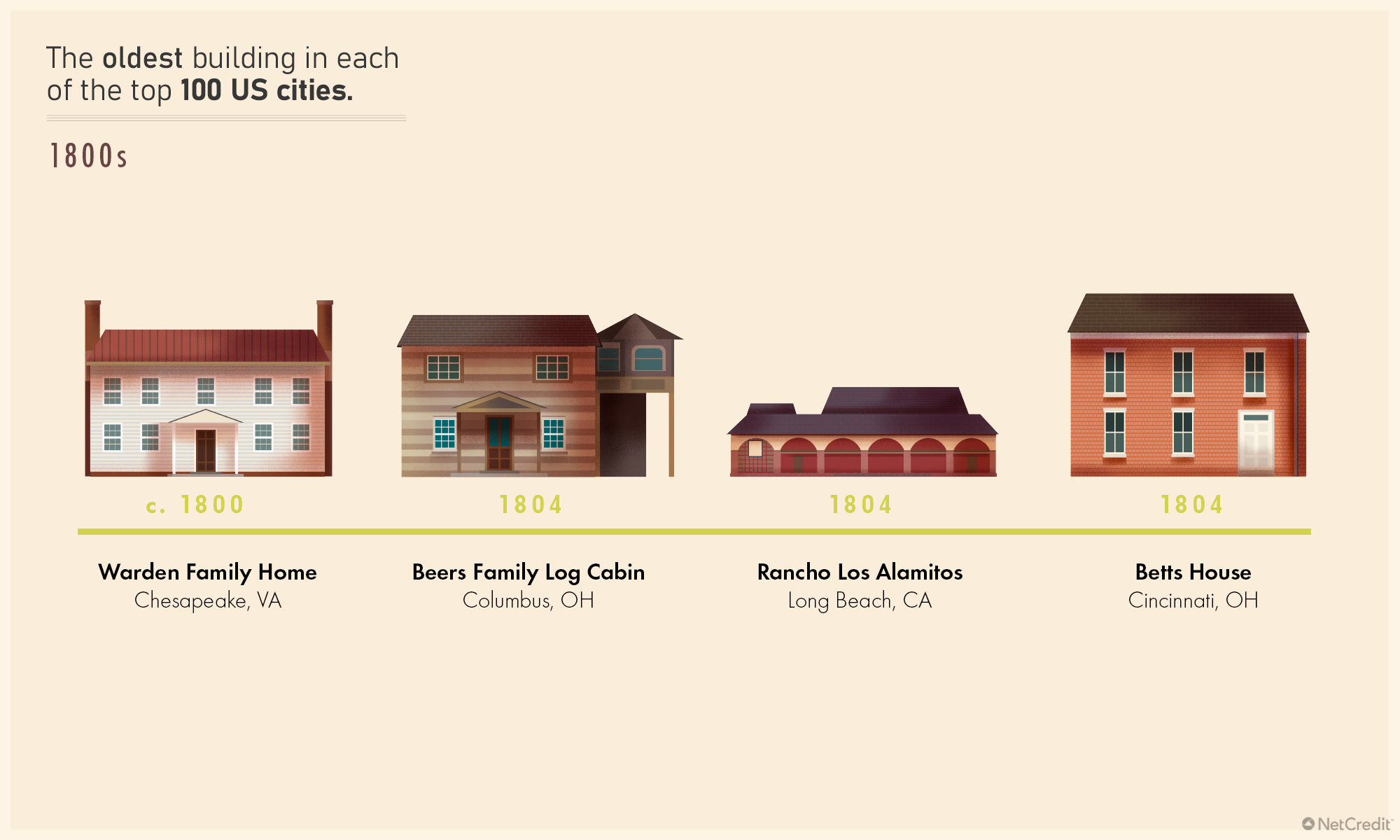
14. 1810s
Master cabinetmaker Van Neman Zevely was exiled from the strict Moravian community of Salem when he married against the will of the Elders. Zevely and his wife moved to ‘Petersbach’ (the Peter’s Creek area of Winston) and built a brick-framed house with walls 18 inches thick. As the town expanded, the home was absorbed into the city of Winston-Salem. Its sturdy brick walls mean it has survived even as its wooden-frame neighbors perished.
The oldest house in Buffalo, NY was built the same year – 1815. It is a three-story, 4,902-square-foot Federal-style house. Known as Colt House, it was one of the first structures to rise from the ashes of the Battle of Buffalo.
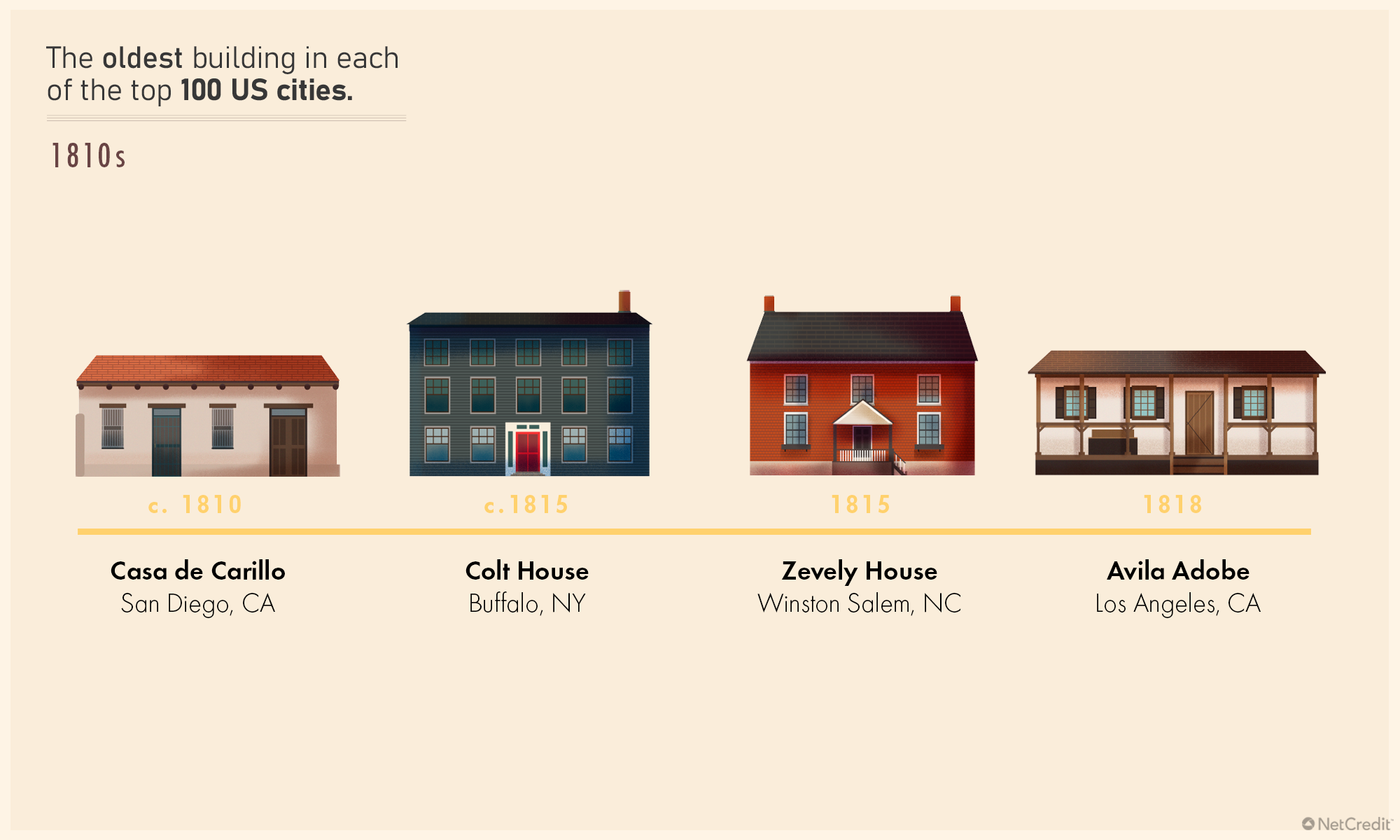
15. 1820s
Baton Rouge’s oldest buildings are an instant leap back through Louisiana time. The Tessier Buildings comprise a row of urban townhouses with brick cornices, casement doors and the kind of fancy cast-iron galleries that characterized Baton Rouge in the 1820s.
Nashville’s oldest is the Federal-style building at 104 Fifth Avenue. It once covered part of the Underground Railroad used to help slaves escape the South. More recently, it has been used as a bar with a rooftop terrace. It sold for $1.87 million in 2012. Honolulu, Cleveland and Detroit are among other cities that can trace their oldest buildings back to the 1820s.
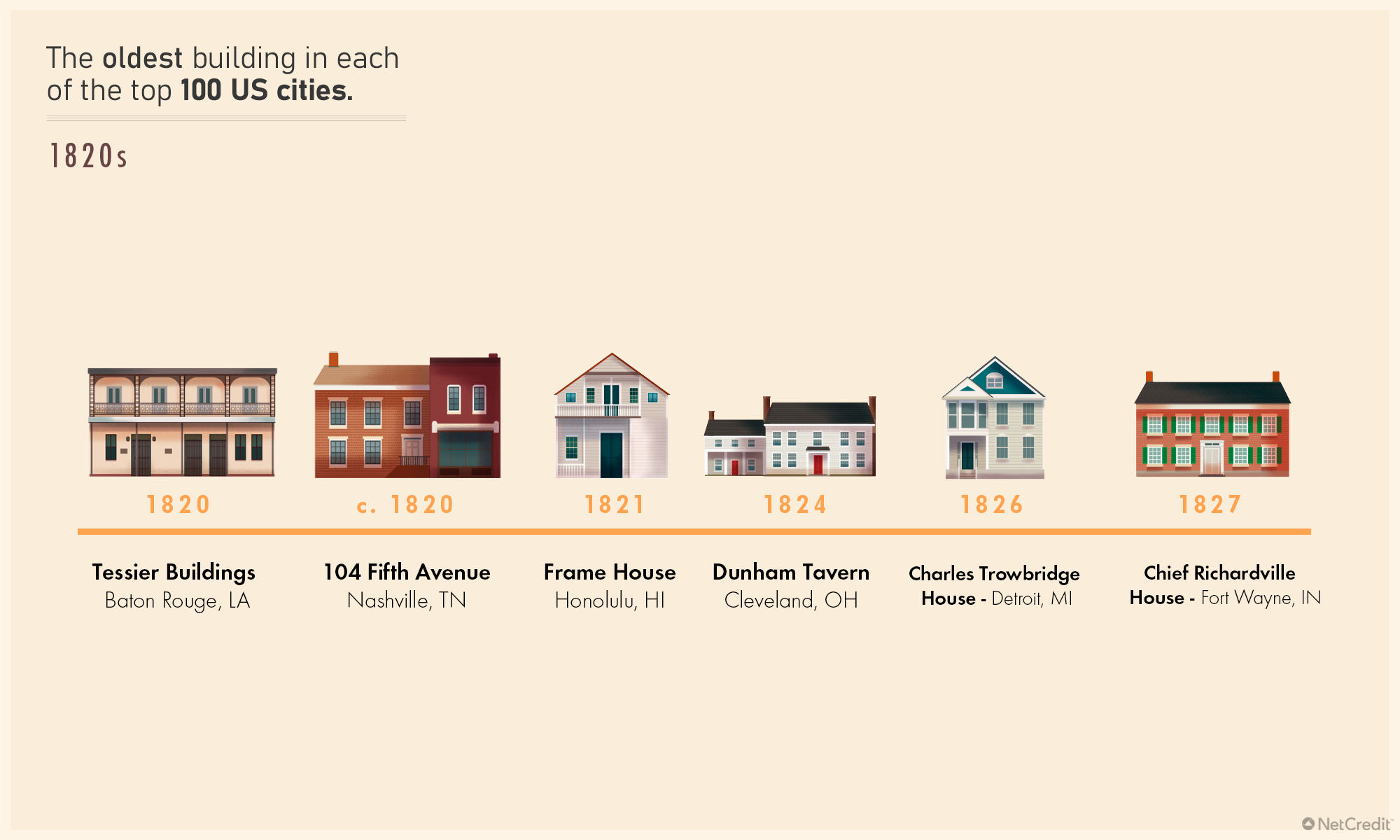
16. 1830s
Laredo boasts a unique piece of history embedded in its oldest structure. It began life as a residential building but became the capital of the Republic of the Río Grande for 11 months in 1840, until the republic’s short-lived period of independence was ended by the Mexican army. Today, the building is a museum.
Chicago’s oldest building is a point of contention. The Noble-Seymour-Crippen House was built in 1833 but didn’t become part of Chicago until the boundary lines were changed in 1893. On the other hand, the Clarke House Museum has been part of Chicago since the city was incorporated in 1837 – but it was built three years after the Noble-Seymour-Crippen House. We went with the first to be built. Which one do you think should hold the title of Chicago’s oldest building?
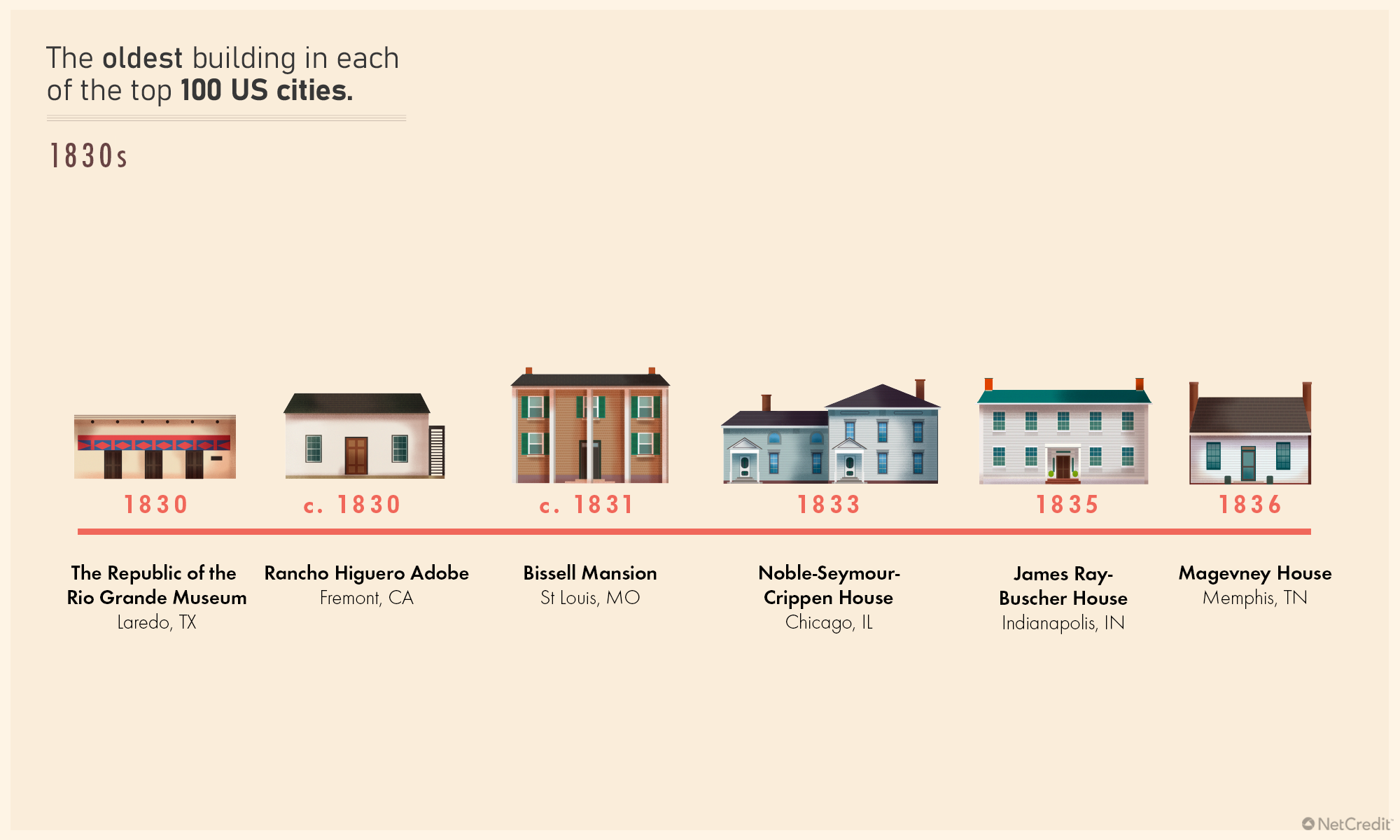
17. 1840s
Early Atlanta settler James Willis was the first to live at what is now 1571 Willis Mill Road, in 1840. Brigadier General Jacob D. Cox took it as his headquarters during the Battle of Atlanta, nicknaming it the “bomb-proof house” after three families survived the 1864 siege inside.
In Miami, the oldest building is the Fort Dallas Barracks – also known as the William English Slave Plantation Longhouse. English raised his plantation on a 640-acre estate on the north bank of the Miami River, growing sugar, pineapple and limes. This stone structure was probably lodgings for the slaves that William English exploited. The US Army requisitioned English’s property in 1849, and Union forces used it during the Civil War. It later became the headquarters of the Daughters of the American Revolution and was moved brick-by-brick to its present location in 1925.
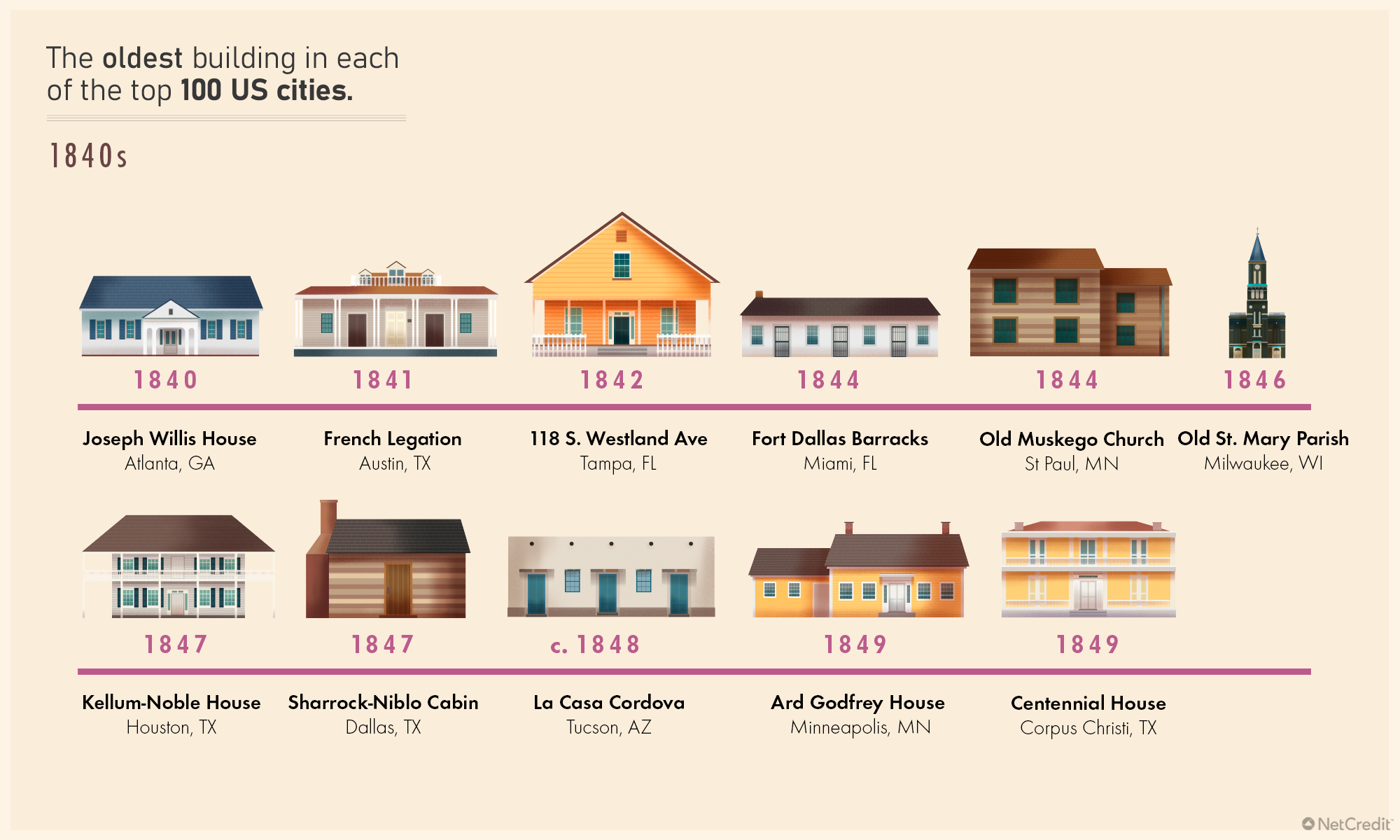
18. 1850s
Las Vegas may be famous for its casinos, but the oldest building in the city is the Old Las Vegas Mormon Fort. This 1855-built adobe structure was the first permanent colonial settlement in the valley and acted as a stopping point for travelers between Salt Lake City and Los Angeles.
The 1852 Lady Adams Building at 113-115 K Street, Sacramento, was named after the brigantine its German immigrant owners arrived on. They are said to have built it from the brick that was used as ballast on board the Lady Adams. This was one of the few buildings to survive the 1852 fire that razed 85% of Sacramento to the ground.
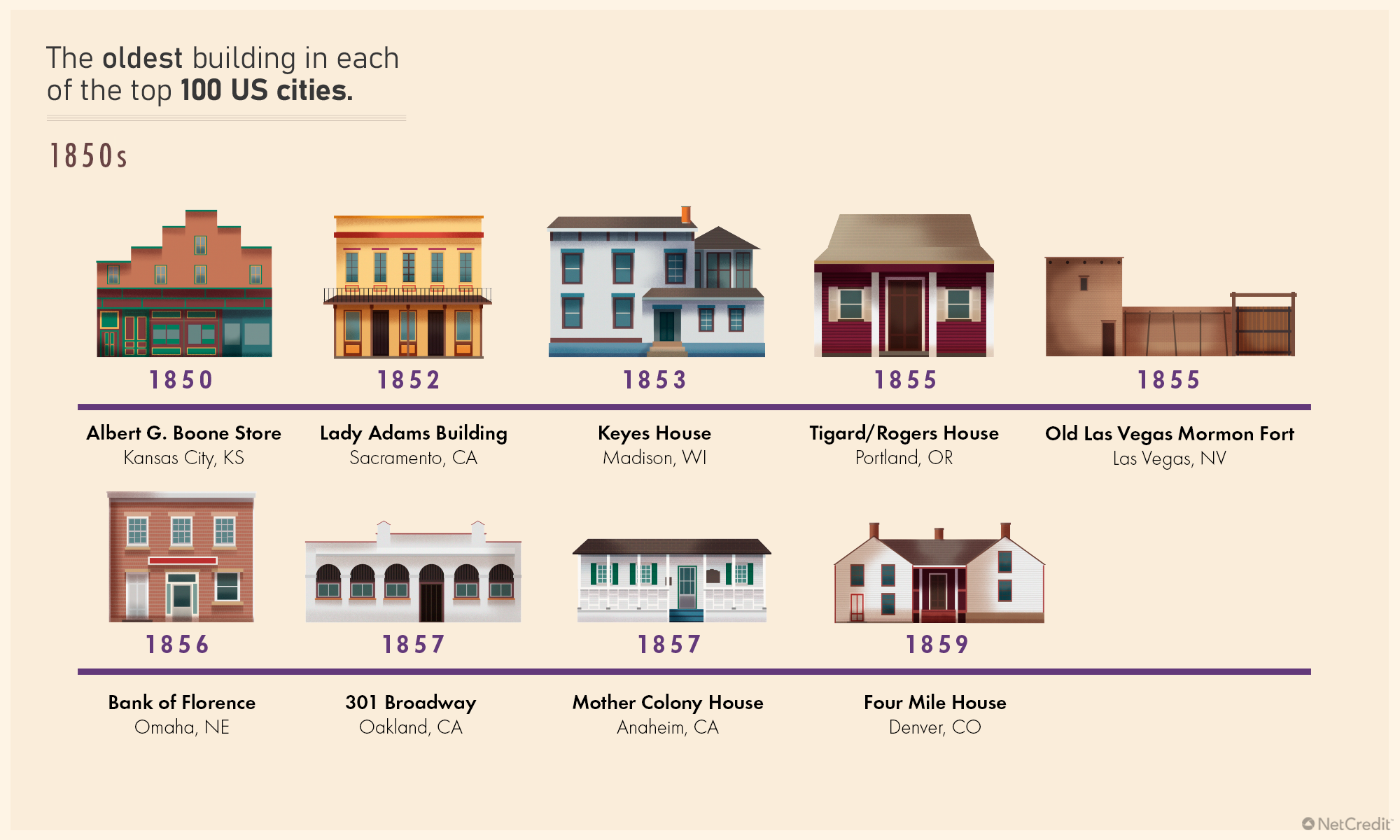
19. 1860s
The oldest house in Plano, north Texas, briefly became a mobile home in 2018. The two-story Collinwood House was built around 1861 and bought by the city in 2009 along with the surrounding farm. The property was intended to become a park, but the cost of restoring the farmhouse proved too much. The building seemed doomed until investors stepped in, lifted the entire building onto the back of a truck, and drove it to a new site.
The 1868 Munger House in Wichita also has itchy feet. The log building has been moved three times in its history – retaining its bizarre foundation of coarse rubble stone, clamshells, sand, water, and buffalo hair.
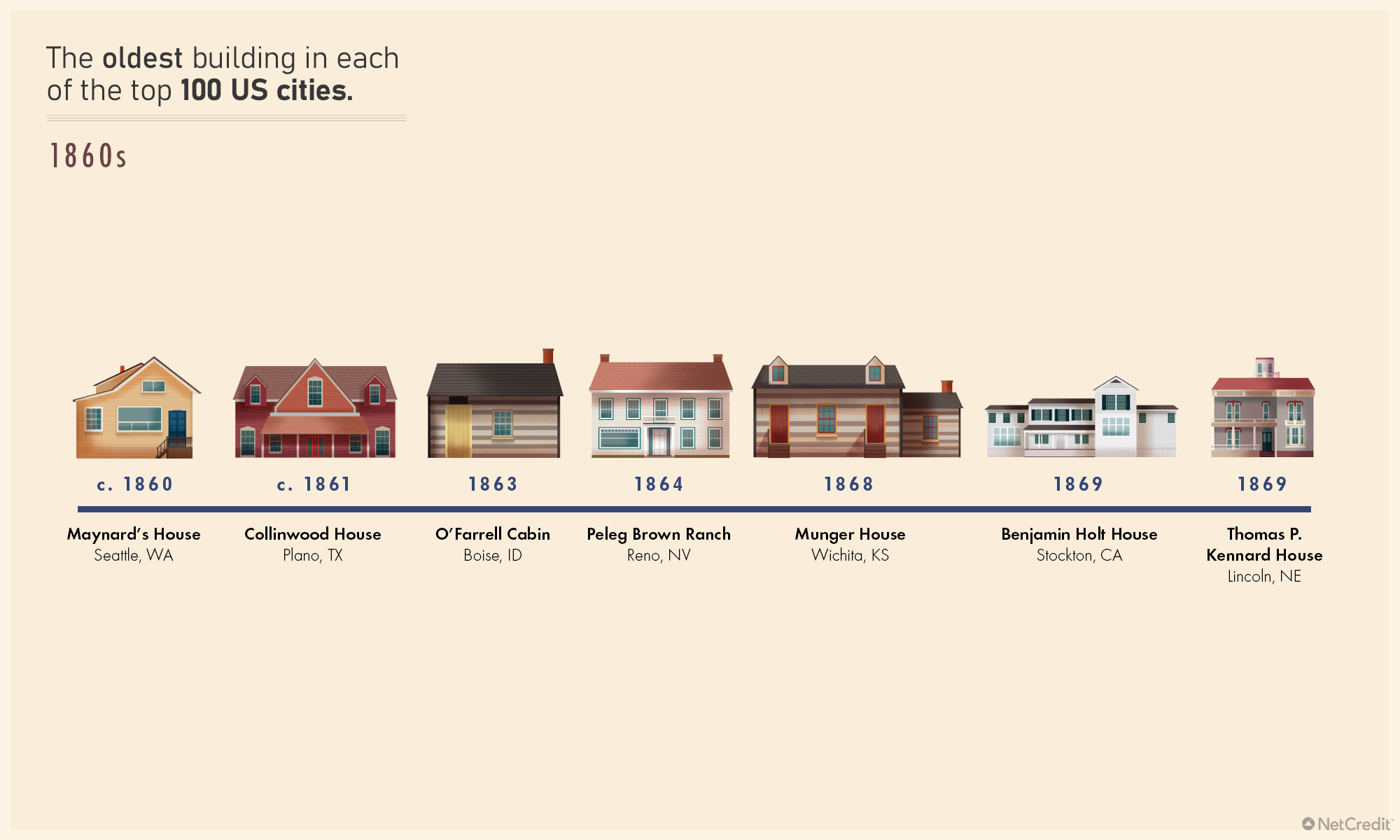
20. 1870s
So many buildings were damaged during the Civil War that many cities can only trace their oldest structures to the 1870s or later. But Phoenix’s oldest place, the 1870 Duppa House, looks like it’s from another time altogether. This two-bedroom adobe home was built by Phillip “Lord” Darrell Duppa, the English settler who gave both Phoenix and Tempe their names. Today it looks like a mud hut with small, ancient glass windows and modern barbed wire to keep squatters out of this near-forgotten dwelling.
The Tinsley-Lyles House in Garland, Texas is a little more conventional. This rural-style farmhouse also plays a big part in Garland’s history, as the owners gave right-of-way permission to the railroads, leading to the development of Garland as a neighborhood.
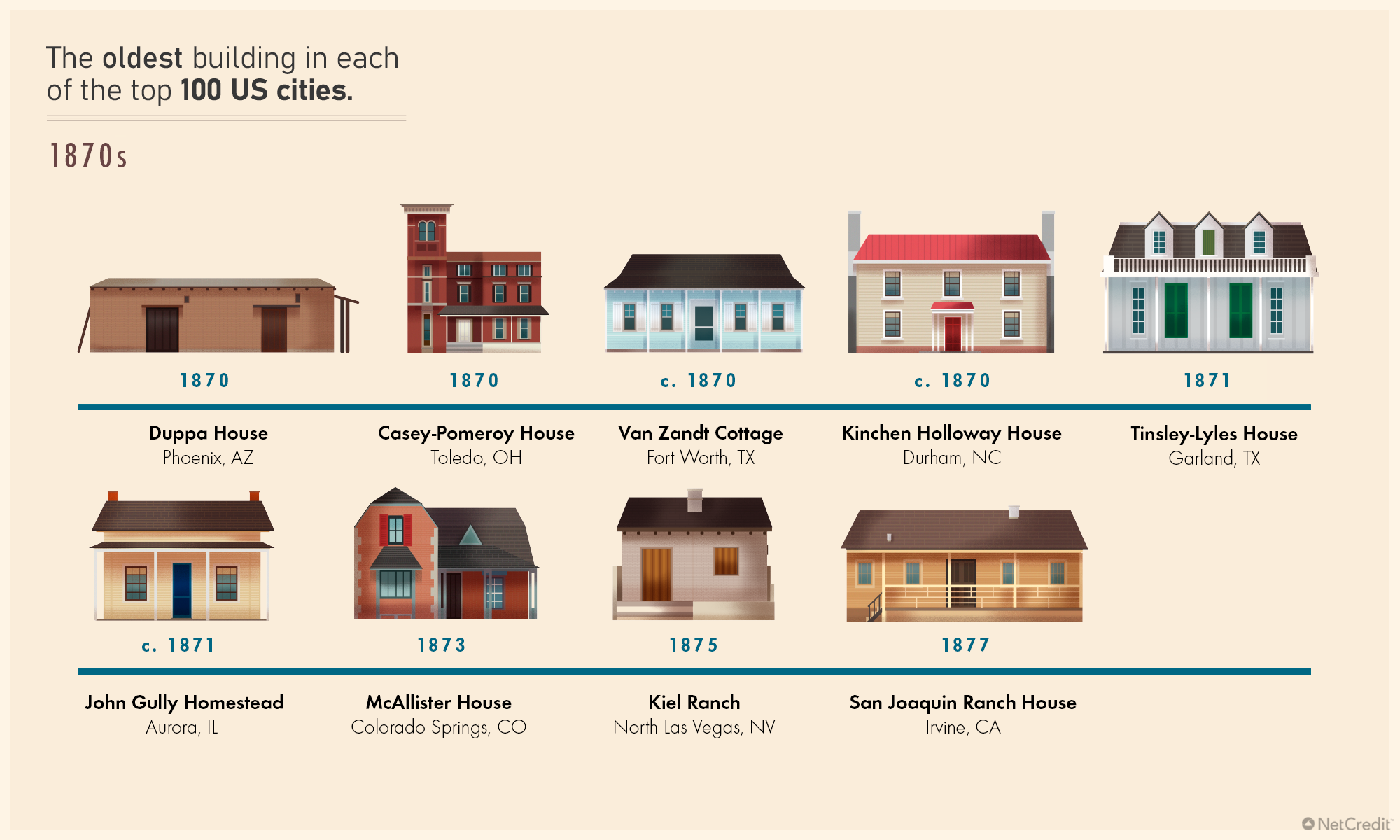
21. 1880s
El Paso’s last surviving false-front wood structure was built in the early 1880s as the city transitioned from adobe village to flourishing railroad town. It is named after William J. Montgomery, who built it and conjures instant images of the Old West with the original decorative wood cornice above its more modern storefront.
The Rogers Building in Orlando is one of “the most distinctive late 19th-century buildings in Central Florida and one of the best-preserved examples of sheet-metal construction in the state.” It is also “incredibly cool” – it was recently donated to the city and is slated to become a hip venue for art and jazz music.
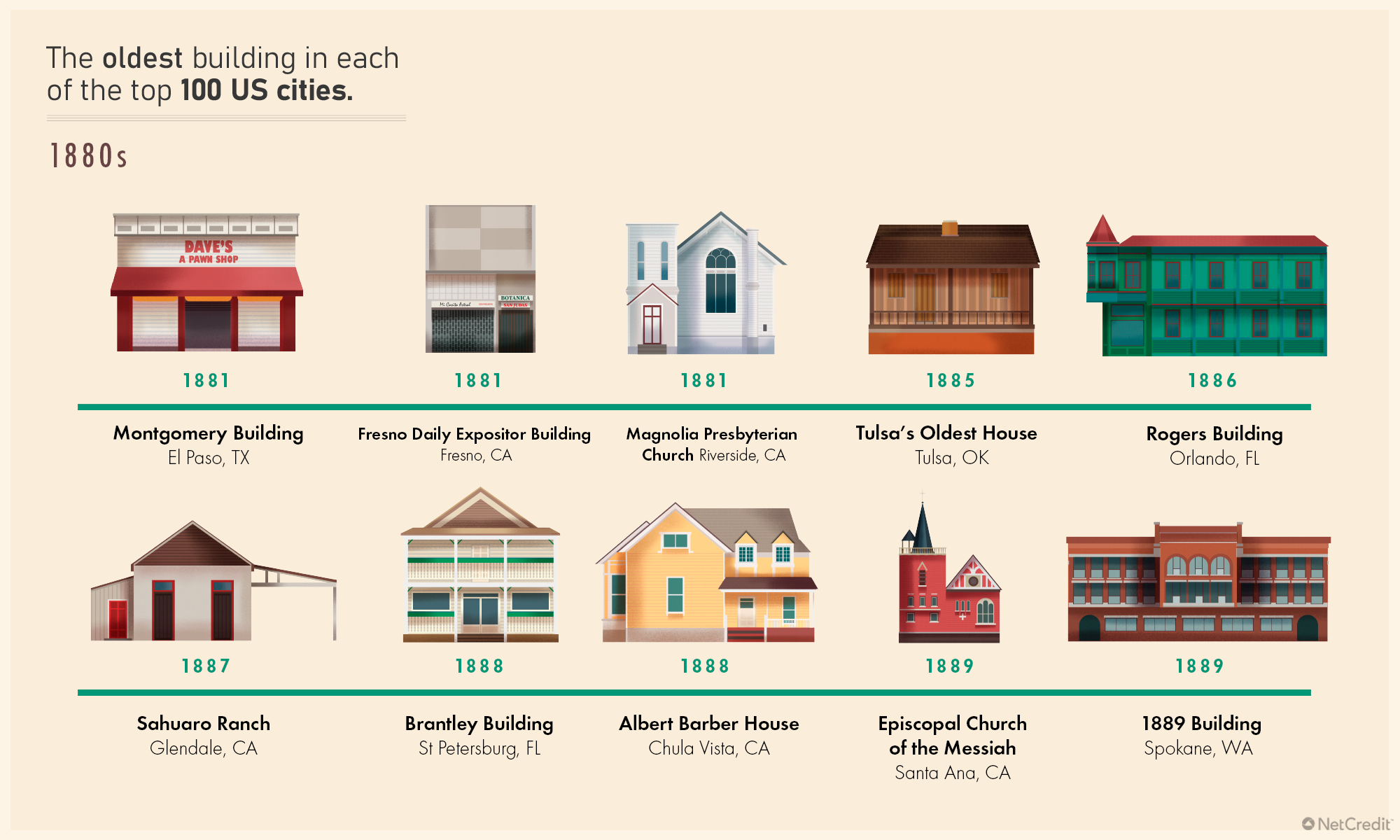
22. 1890s
“My great, great grandfather built the Pomeroy building in 1891,” says Michel Fluhr of Mesa, Arizona’s oldest building, “and my father, Wayne Pomeroy, opened his first store here in 1951.” The city’s first brick structure became the heart of Mesa’s early business district and remains a fixture of local commerce today.
In Scottsdale, the oldest building and last remaining Victorian residence is the Titus House. It was built by one of Arizona’s first and most important architects, the Canadian James M. Creighton, in 1892.
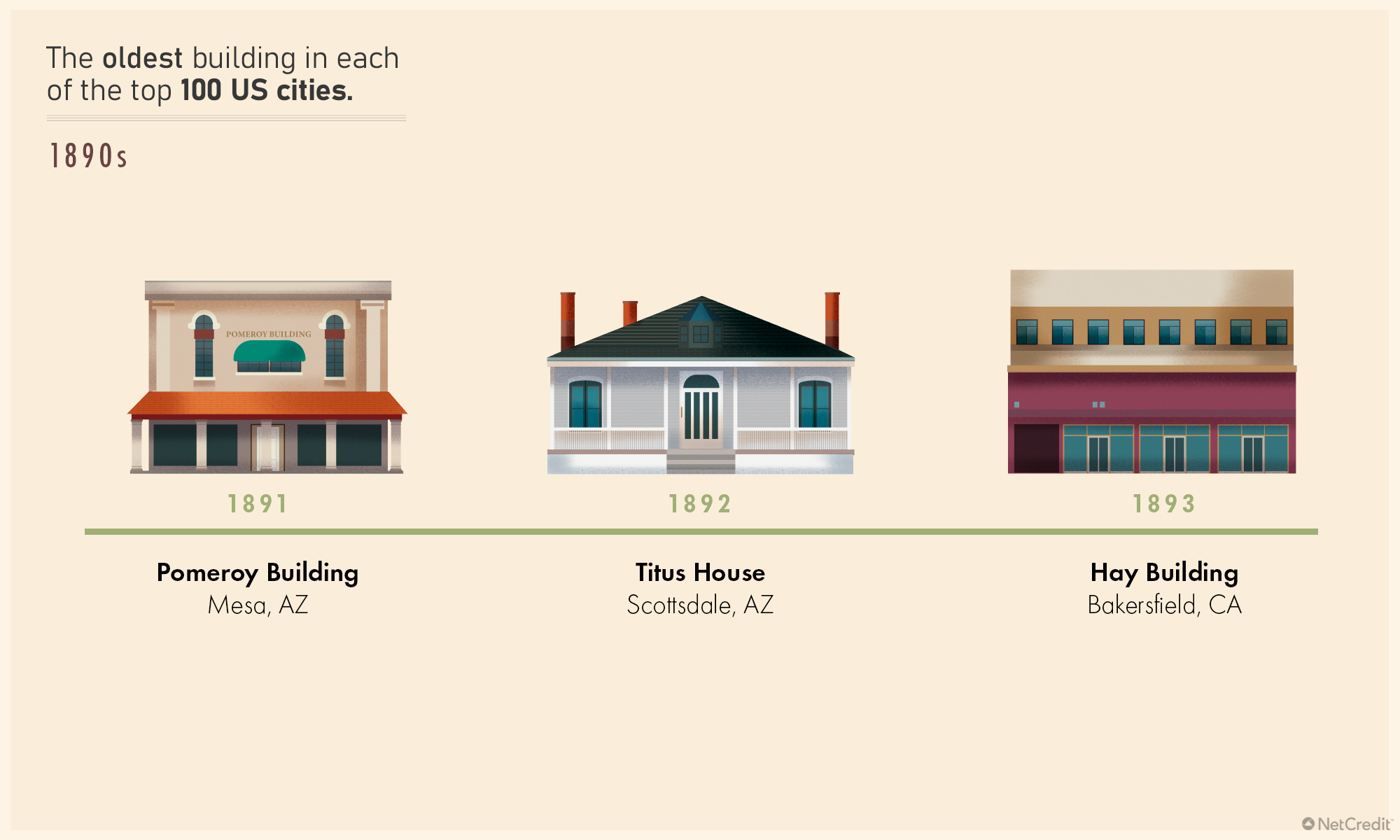
23. 1900s
The extraordinary Overholser Mansion was built by the “Father of Oklahoma City,” Henry Overholser, and his wife in 1903. The city’s first mansion was built in the then-old-fashioned Queen Anne and Chateauesque styles. The Daily Oklahoman described it as “a sermon on beauty. It is uplifting and ennobling as works of art are ever. The taste with which it has been decorated and is being furnished is flawless and shows a praiseworthy mastery of the subject, and the whole Overholser house is an incomparable example of the possibilities of beautiful homebuilding.”
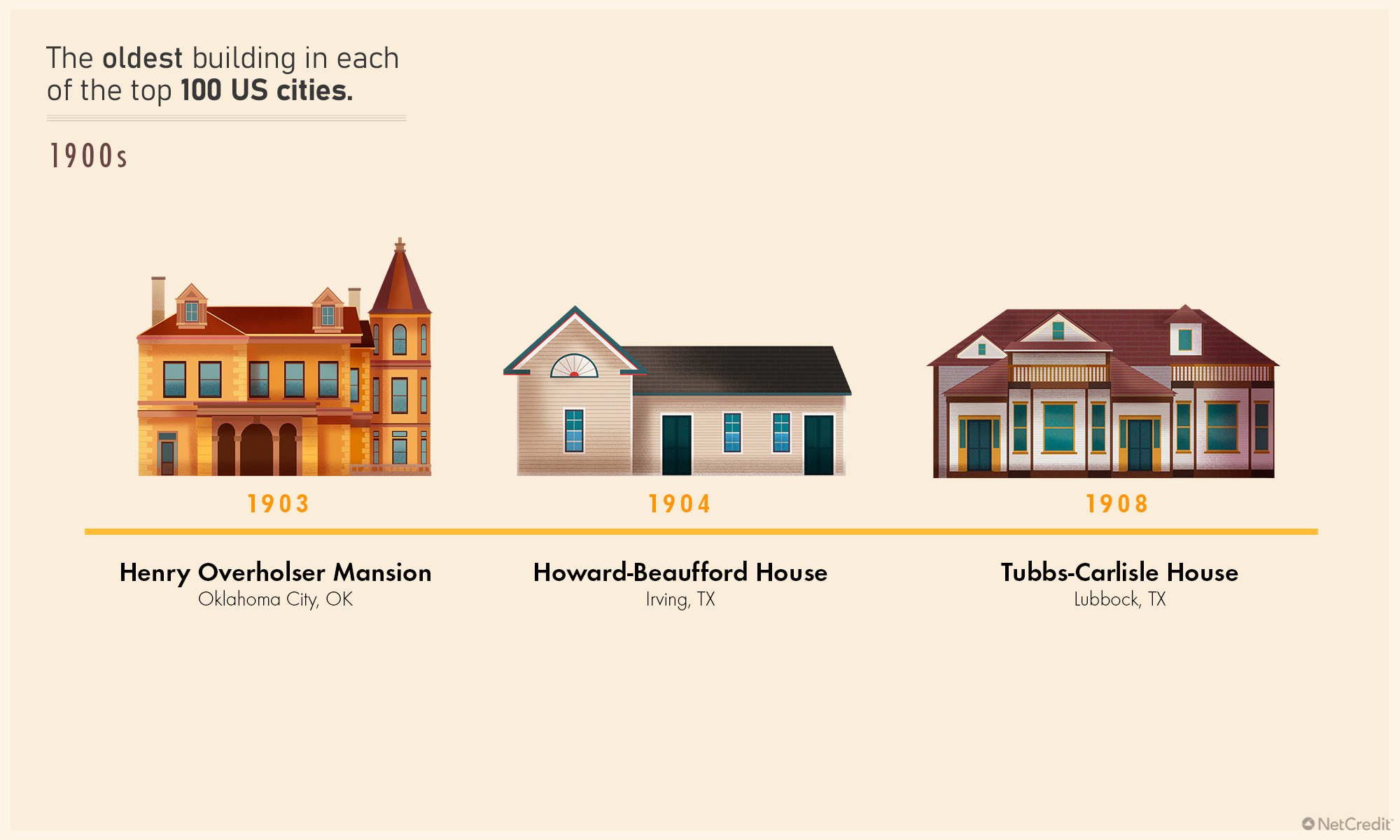
24. 1910s
The 1913 Chandler Bank Building is the oldest building in the eponymous city. It was built just a few months before the San Marcos Hotel (now the Crowne Plaza Phoenix-Chandler Golf Resort). The building fell into disuse for a while but became the San Tan Brewery in September 2007.
The city of Gilbert, Arizona’s oldest is Gilbert Elementary School, which is now the Gilbert Historical Museum. Like Chandler’s oldest, it was built in 1913 – in this case, in the Mission/Spanish Revival style. When the elementary school opened, some pupils would hitch a ride with a farm wagon heading to the nearby creamery to save on shoe leather.
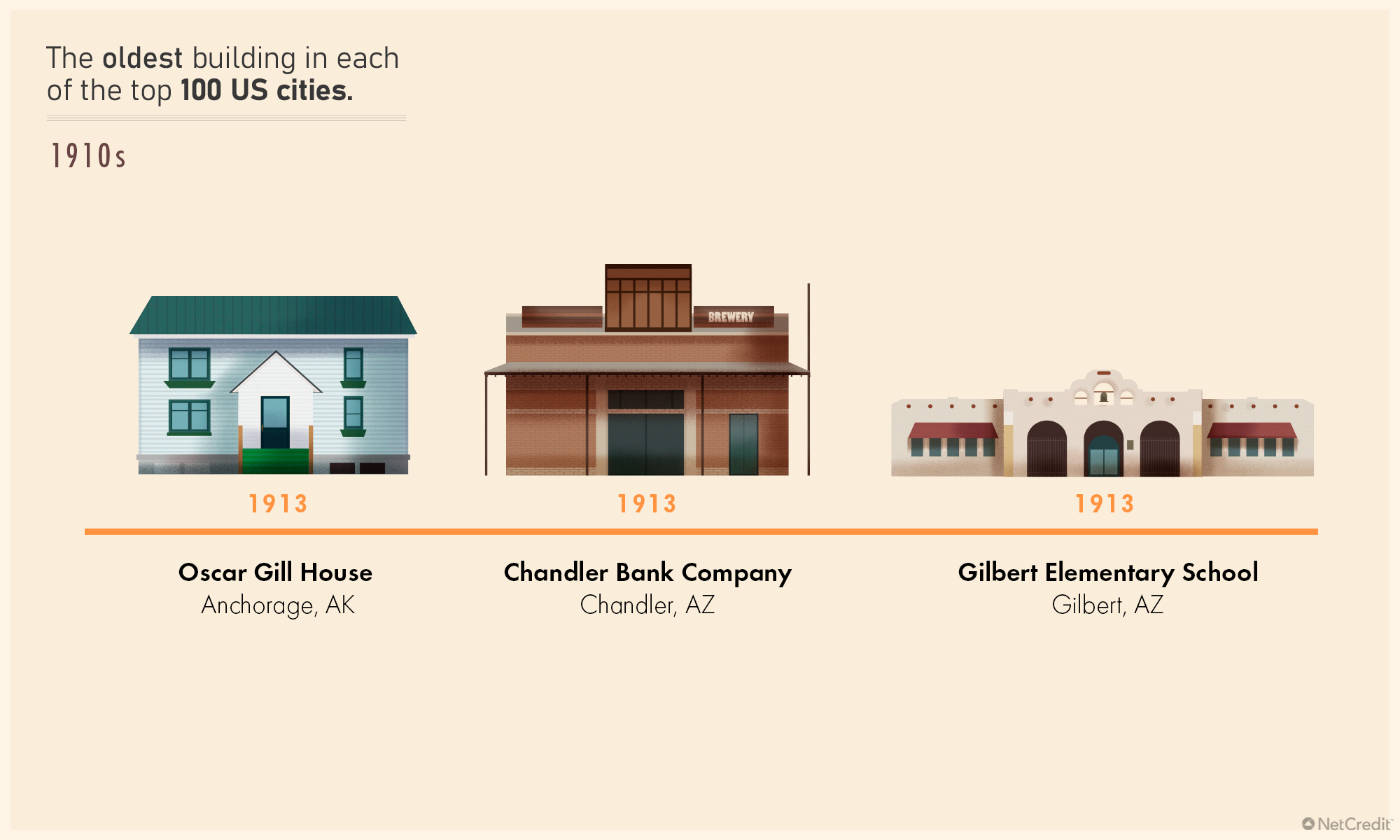
25. 1920s
Just one building on our list was constructed in the 1920s. Its home city, Hialeah, Florida was incorporated in 1925 after just a few years of development. The 1926 Hialeah Seaboard Air Line Railway Station is another Station Mission/Spanish Revival building. The rail station closed for passengers in the 1960s but became the backdrop for a new Tri-Rail commuter rail station in 1989.
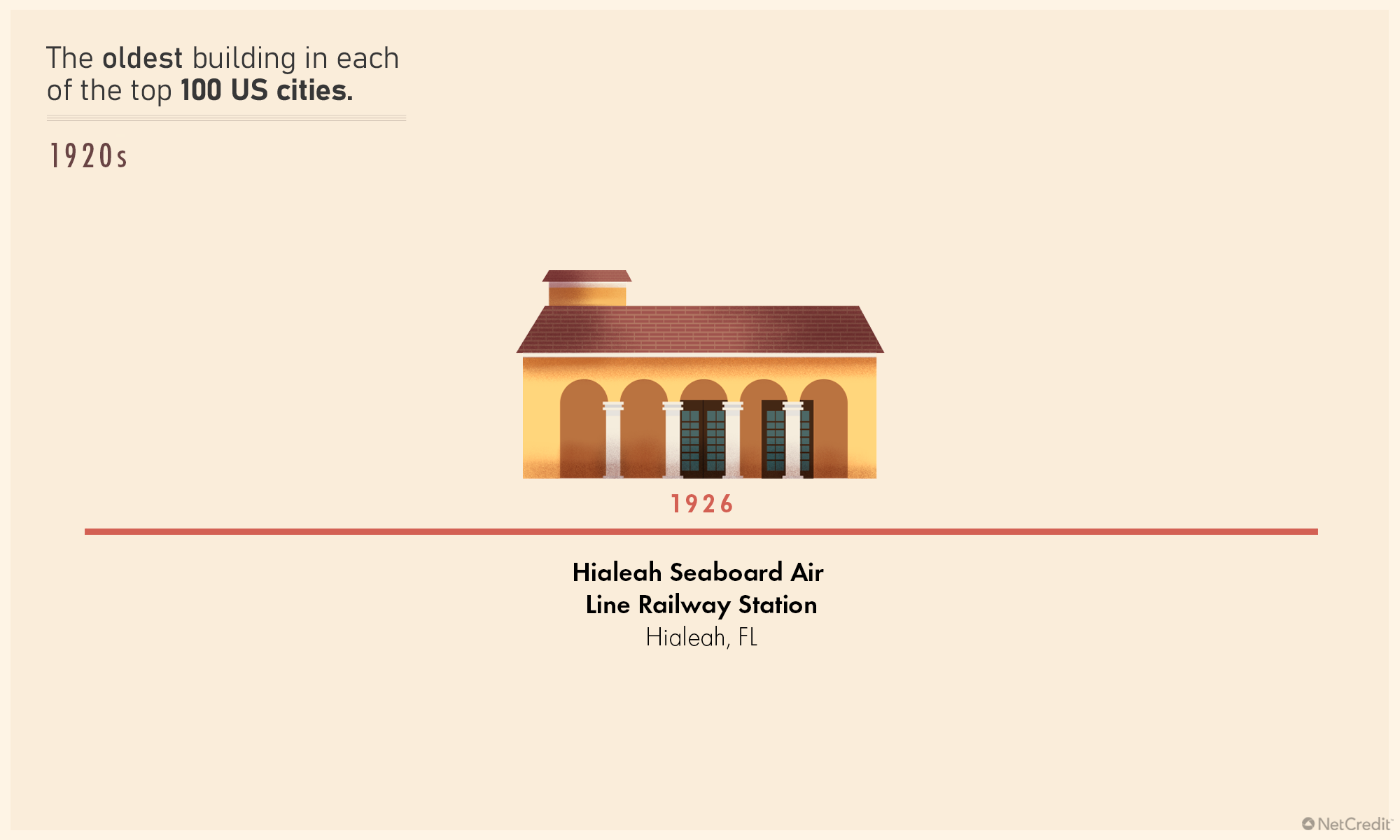
26. 1940s
The most recent building on our list was built in the fifth decade of the 20th century. Why so new? The Old Fire House’s home city, Henderson, was only founded in the 1940s, chiefly as an industrial setting. The Nevada city didn’t become incorporated until 1953. Parts of the city also underwent major redevelopment following the PEPCON rocket fuel factory explosion of 1988 – a blast equal to a 1-kiloton air-blast nuclear detonation. The explosion caused severe damage within a 1.5-mile (2.4 km) radius and less severe structural damage up to three miles away. The Old Fire House, around four miles away, resisted the blast.
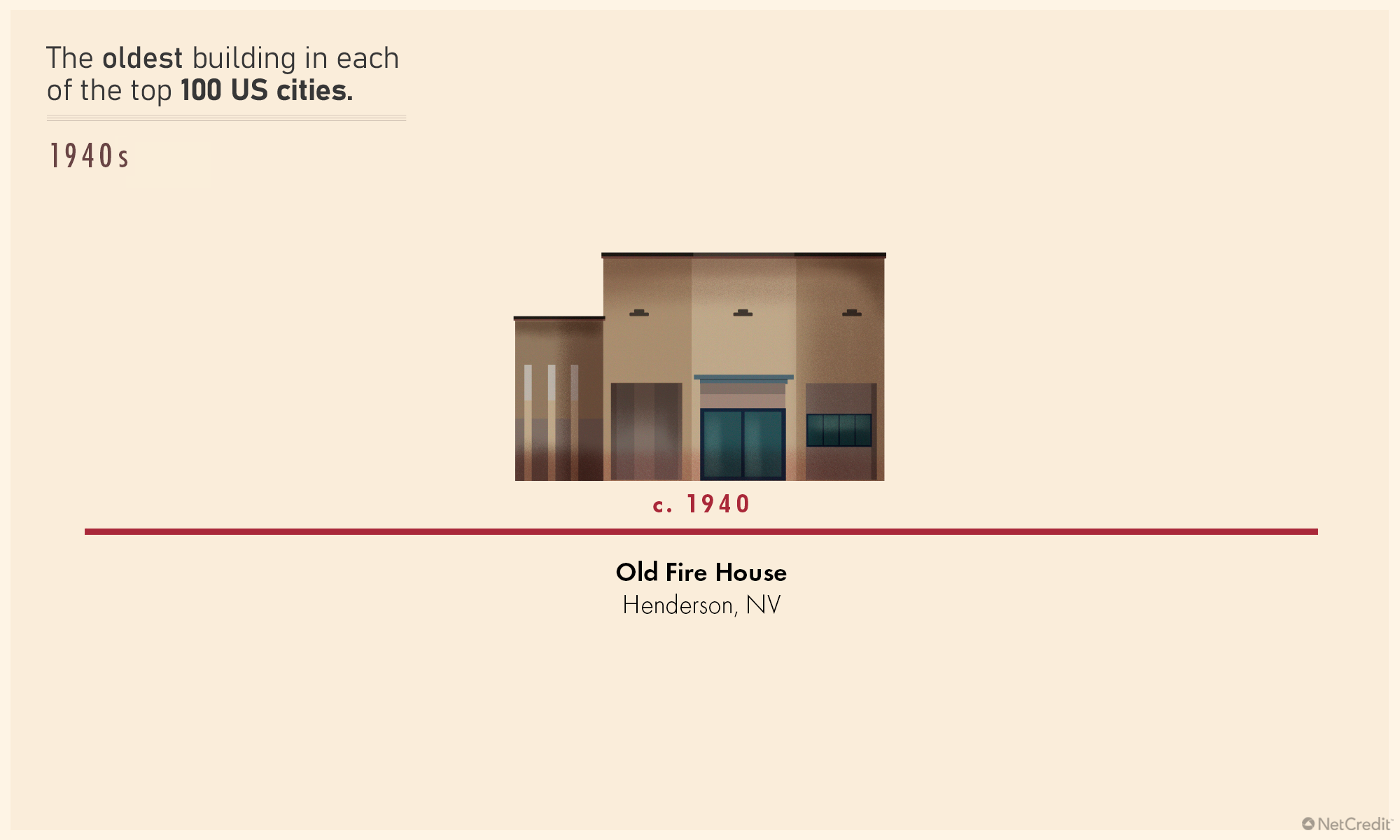
Most of the buildings in the United States disappear in time — whether through neglect, redevelopment or rocket fuel explosion. The oldest buildings that survive in our cities have a special story to tell about where today’s neighborhoods came from and where they are going.
Summary
Having grown up as close as within a mile of the Wyckoff House Museum, it is actually not located in Canarsie, which is in the 11236 ZIP code — it misses it by little more than a short city block — but more accurately rather the East Flatbush section of Brooklyn with the address of 5816 Clarendon Road in the 11203 ZIP code…
…and despite living so close to the Wyckoff House Museum for years, I have never visited it — but I hope to do so one day.
Because John Washington — who was the great grandfather of George Washington — purchased 100 acres of land on the east side of Bridge’s Creek near the confluence of the Potomac River in Virginia in 1664, the building which once housed the birthplace of George Washington would not be as old as the Wyckoff House.
Please read about my experience at the George Washington Birthplace National Monument, where I stood on the spot at which the first president of the United States was born. Photograph ©2017 by Brian Cohen.

